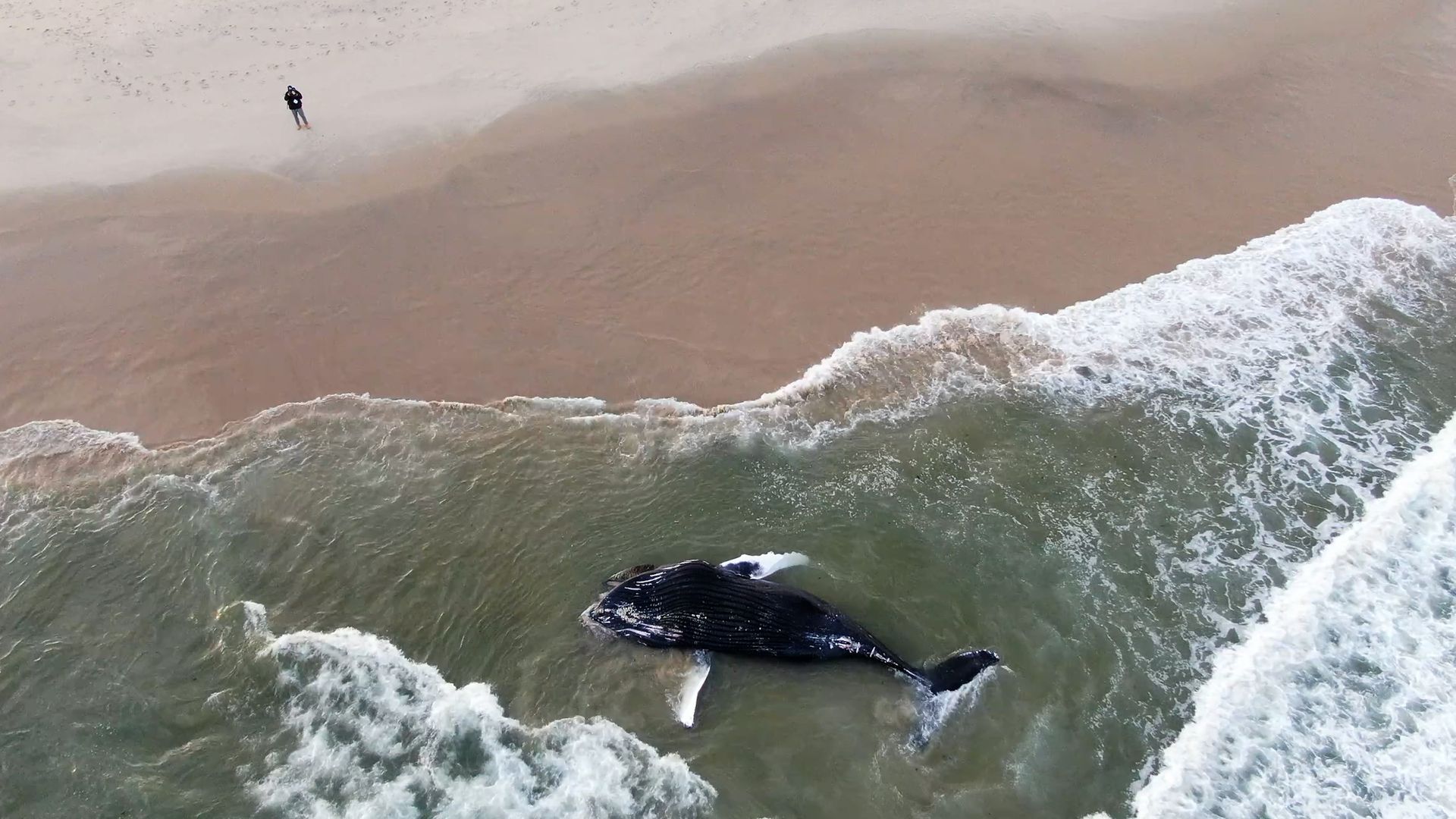
BOB STERN: WHALES WASH UP ON SHORE, OBVIOUSLY DEAD. AND THAT IS EXTREMELY UNUSUAL.
CINDY ZIPF: IT’S VERY MOVING IN A BAD WAY TO SEE THAT… SOMETHING THAT’S SO MAJESTIC AND SO BEAUTIFUL, JUST KIND OF LIFELESS ON LAND.
BONNIE BRADY: I WOULD THINK, OVER THE LAST 7 YEARS OF MARINE MAMMAL DEATHS, THE MARINE MAMMALS MIGHT BE TRYING TO TELL US SOMETHING.
STERN: WE SUSPECTED, AND STILL SUSPECT THAT THE CAUSE OF THAT WAS THE VESSEL SURVEYS, THAT A NUMBER OF THE WIND COMPANIES ARE NOW DOING OFFSHORE.
LONGWORTH: BEFORE BUILDING A WIND FARM OFFSHORE, DEVELOPERS MAP THE SEAFLOOR AND THE GEOLOGICAL LAYERS BENEATH IT USING SOUND WAVES. IT’S CALLED A GEOPHYSICAL SURVEY.
WE MET WITH MEMBERS OF COASTAL COMMUNITIES IN NEW YORK AND NEW JERSEY WHO BELIEVE THE SURVEY SOUNDS MAY BE DISORIENTING WHALES, LEAVING THEM MORE LIKELY TO COLLIDE WITH SHIPS.
BRADY: THEY’VE BEEN DOING ALL THIS WORK. AND ABOUT THE TIME THAT THE WORK STARTED IS WHEN THE WHALES STARTED PILING UP.
LONGWORTH: NOAA CONSIDERS THE HUMPBACK WHALE STRANDINGS–SINCE 2016–AND THE MINKE, AND NORTH ATLANTIC RIGHT WHALE STRANDINGS–SINCE 2017–“UNUSUAL MORTALITY EVENTS,” OR UMES
THAT MEANS AN UNEXPECTED, SIGNIFICANT NUMBER OF WHALES HAVE STRANDED SINCE 2016… AND IT’S HAPPENED AS SURVEY WORK PICKED UP IN THE ATLANTIC, LEADING SOME TO ASK THAT THEIR STATES PUMP THE BRAKES ON OFFSHORE WIND.
ZIPF: IN THIS REGION, WE DID CALL FOR A PAUSE–A HALT–TO ANY ACTIVITY, SO WE COULD DETERMINE WHETHER OR NOT THE UNPRECEDENTED AMOUNT OF PRE CONSTRUCTION ACTIVITY…MAY HAVE HAD SOMETHING TO DO WITH THIS INCREDIBLY DEVASTATING SPIKE IN WHALE AND DOLPHIN DEATHS THAT OCCURRED.
WHILE DEVELOPERS HAVE DONE SURVEYS FOR MORE THAN A DECADE, SEVERAL PROJECTS BEGAN IN THE NORTHEAST AROUND THE TIME THAT WHALE STRANDINGS BEGAN CLIMBING IN 2016.
THAT YEAR, US WIND PERFORMED SURVEYS NEAR MARYLAND AND DONG ENERGY–NOW ORSTED–WORKED OFF OF MASSACHUSETTS INTO THE FOLLOWING YEAR.
IN 2017, OCEAN WIND AND DEEPWATER WIND CONDUCTED SURVEYS OFF NEW JERSEY AND NEW YORK.
CRITICS AREN’T SAYING THAT SOUNDS ARE DIRECTLY KILLING WHALES. THEY’RE SPECULATING THAT SOUNDS ARE DISRUPTING BEHAVIOR, MAKING WHALES MORE LIKELY TO COLLIDE WITH SHIPS AND DIE.
NOAA FISHERIES SAYS THERE’S “NO SCIENTIFIC EVIDENCE” THAT NOISE RESULTING FROM OFFSHORE WIND SURVEYS COULD CAUSE MORTALITY OF WHALES.
INSTEAD, THE AGENCY BLAMES CLIMATE CHANGE FOR DRIVING WHALES CLOSER TO SHORE, PUTTING THEM AT HIGHER RISK FOR VESSEL STRIKES AND ENTANGLEMENT. THIS WOULD MAKE OFFSHORE WIND THE SOLUTION TO THE WHALE PROBLEM, RATHER THAN THE CAUSE… THAT IS, IF IT CAN REDUCE CLIMATE CHANGE.
NEITHER SIDE KNOWS WHAT’S CAUSING THE UNUSUAL MORTALITY EVENTS. ONE SAYS IT’S THE INCREASED SOUNDS FROM OFFSHORE WIND, THE OTHER SAYS GLOBAL WARMING…
BOTH ARE SPECULATING, BUT ONLY ONE SIDE IS BEING TAKEN SERIOUSLY.
THE OTHER IS BEING DISCREDITED BY THE MEDIA.
TV CLIP
CHRIS SMITH: THEY SAY IT’S MISINFORMATION OR DISINFORMATION. NO, THESE ARE REASONABLE QUESTIONS WE NEED TO ASK ABOUT THE ABILITY OF THESE SEA CREATURES TO SURVIVE AND THRIVE.
BRADY: THIS IS AN ISSUE, BUT WHEN YOU SAY THAT, I’M A “CYNICAL DISINFORMATION EXPERT”
LONGWORTH: THE SITUATION HAS BECOME OVERTLY PARTISAN IN NATIONAL DISCOURSE. THOSE WE INTERVIEWED HAVE BEEN ACCUSED OF BEING PAWNS FOR THE FOSSIL FUEL INDUSTRY, AND “RIGHT-WING”, REGARDLESS OF THEIR TRUE POLITICAL LEANINGS.
STERN: WHEN PEOPLE BRING THAT UP TO ME, IT JUST INDICATES THAT THEY’RE JUST UNABLE OR UNWILLING TO TALK ABOUT THE SUBSTANCE OF THE PROBLEMS. I DON’T BELIEVE THE MEDIA HAS DONE A GOOD JOB.
TO US THIS IS NOT POLITICAL… I’M AN OFFICER WITH THE DEMOCRATIC CLUB ON LONG BEACH ISLAND… AND NOBODY’S KICKED ME OUT OF THE CLUB YET … ON THIS PARTICULAR ISSUE, YEAH, I HAVE TO PART COMPANY WITH SOME OF OUR DEMOCRATIC REPRESENTATIVES.
ZIPF: THE OCEAN CONCERN IS BEING USED AS SORT OF A POLITICAL TOOL AND NOT AS AN ISSUE OF PARAMOUNT IMPORTANCE FOR ALL OF US.
STERN: REMARKS BY PROPONENTS, WHEN THEY COME OUT, AND THEY SAY THINGS LIKE, WE’RE GOING TO TACKLE CLIMATE CHANGE, OR WE’RE GOING TO CREATE 10S OF 1000S OF JOBS AND YOUR ELECTRIC BILLS WILL GO DOWN, THAT THOSE STATEMENTS ARE PRINTED, BECAUSE THEY’RE COMING FROM OFFICIALS OR ELECTED OFFICIALS, AGENCY HEADS OR WHATEVER. BUT WHEN A GROUP LIKE OURS TRIES TO GO BACK TO THAT NEWSPAPER OUTLET AND SAY IN A PRESS RELEASE, NAH, IT’S REALLY NOT THE CASE. YOU KNOW, YOU’RE ONLY GONNA HAVE A FEW TEMPORARY JOBS. YOU’RE NOT ADDRESSING CLIMATE CHANGE, THAT DOES NOT GET PRINTED.”
LONGWORTH: THE FINAL ENVIRONMENTAL IMPACT STATEMENT FOR VINEYARD WIND STATES CLEARLY THAT OFFSHORE WIND PROJECTS WOULD HAVE “NO COLLECTIVE IMPACT ON GLOBAL WARMING.” BUT THEY “MAY BENEFICIALLY CONTRIBUTE TO A BROADER COMBINATION OF ACTIONS.”
VINEYARD WIND DECLINED AN INTERVIEW, BUT WHEN QUESTIONED ABOUT THE MULTI-BILLION-DOLLAR PROJECT’S LACK OF IMPACT ON GLOBAL WARMING, THEY REPLIED: “[IT] WILL SHOW THAT WE CAN RESPONSIBLY BUILD CLEAN ENERGY PROJECTS THAT MOVE US FORWARD IN THE FIGHT AGAINST CLIMATE CHANGE.”
THE HASTE WITH WHICH WE’RE BUILDING THIS INFRASTRUCTURE IS UNDENIABLE. PRESIDENT BIDEN WANTS WIND ENERGY TO PRODUCE 30 GIGAWATTS OF ELECTRICITY BY 2030.
JOE BIDEN: 30 GIGAWATTS IS ENOUGH TO POWER 10 MILLION HOMES. IT’LL HELP PUT US ON A PATH TO 100 PERCENT CLEAN ENERGY BY 2035.
HOWEVER LOFTY THAT GOAL, GOVERNORS IN THE NORTHEAST–MOSTLY DEMOCRATS–ARE ON BOARD.
KATHY HOCHUL: [AND] WE KNOW THAT THE FUTURE DOES LIE IN CLEAN ENERGY, AND RIGHT HERE THAT MEANS OFFSHORE WIND.
STERN: I THINK NEITHER PARTY IS REALLY ADDRESSING THIS PROBLEM OF CLIMATE CHANGE AND SEA LEVEL RISE WELL. I THINK YOU HAVE A NUMBER OF PEOPLE IN ONE PARTY WHO ARE DENYING THE PROBLEM. AND THEN YOU HAVE THE NUMBER OF PEOPLE IN THE OTHER PARTY, SAYING THEY CAN SOLVE THE PROBLEM WITH SOME WIND TURBINES. NEITHER IS ACCURATE. AND NEITHER FRANKLY, IS USEFUL.
DARLENE KETTEN: MY NAME IS DARLENE KETTEN. I’M A RESEARCH SCIENTIST. I WORK PRIMARILY ON HEARING AND HEARING PARTICULARLY IN MARINE ORGANISMS, BUT ALSO IN HUMANS.
THERE’S NO EVIDENCE THAT HEARING HAS HAD A ROLE IN THOSE SHIP STRIKES. I’M NOT SAYING THAT IT DIDN’T. BUT TO THE BEST OF MY KNOWLEDGE, THERE HASN’T BEEN AN EXTENSIVE EXAMINATION, OR ANY KIND OF PROCEDURES TO DETERMINE IF THE ANIMALS THAT ARE BEING HIT BY SHIPS HAVE HEARING DEFICITS.
IF THE WHALES ARE TRYING TO TELL US SOMETHING, WE CAN’T HEAR IT. WE DON’T HAVE ENOUGH DATA FROM THE WASHED-UP WHALES THEMSELVES TO EVALUATE WHETHER HEARING DAMAGE PLAYED A ROLE IN THEIR STRANDINGS.
ACCORDING TO KETTEN, WHEN NECROPSIES ARE DONE, THERE ARE A LOT OF CHALLENGES: NOT ALL HEARING LOSS IS VISIBLE POST-MORTEM. THE WHALE COULD BE TOO DECOMPOSED WHEN IT GETS TO SHORE. IT’S ALSO JUST REALLY DIFFICULT TO CUT THE EAR OUT OF A 40-TON MAMMAL. IN TRUTH, RESPONDERS AREN’T REQUIRED TO COLLECT INFORMATION ON HEARING DAMAGE AT ALL.
SO WE DON’T KNOW FOR SURE WHETHER HEARING LOSS IS PLAYING AN INDIRECT PART IN WHALE DEATHS. BUT WE DO KNOW THAT THE CURRENT ACTIVITY BY OFFSHORE DEVELOPERS CAN DISTURB THEM. THEY APPLY FOR AUTHORIZATION TO DO SO THROUGH NOAA.
KETTEN: THE DEGREE OF DISTURBANCE IS THE QUESTION.
IT’S LIKELY THAT THEY WOULD LEAVE THE AREA, LEAVING THE AREA COULD BE AN IMPORTANT PROBLEM. IF THEY LEAVE THE AREA AND IT TURNS OUT THAT’S WHERE THEIR MAJOR SOURCE OF FOOD IS… THEN WE’VE DISTURBED THEIR ABILITY TO FORAGE TO FEED. AND THAT CAN ALSO HAPPEN FOR BREEDING HABITATS, ETC.”
LONGWORTH: THEY WOULDN’T APPLY FOR AN INCIDENTAL HARASSMENT AUTHORIZATION IF THEY DIDN’T THINK THEIR WORK COULD AFFECT MARINE LIFE.
DOCUMENTS FOR THE ATLANTIC SHORES PROJECT, FOR EXAMPLE, STATES PLAINLY THAT THE SOUNDS FROM SURVEY WORK HAVE POTENTIAL FOR “BEHAVIORAL HARASSMENT.” AND BEHAVIORAL HARASSMENT INCLUDES TEMPORARY HEARING LOSS.
DURING CONSTRUCTION, THE AUTHORIZATIONS ALLOW FOR PERMANENT HEARING LOSS. MORE PROJECTS ARE NEARING THE CONSTRUCTION PHASE.
THE NOISY PART OF THE CONSTRUCTION IS THE “PILE DRIVING.” HAMMERING A GIANT PILE INTO THE OCEAN FLOOR TO SECURE EACH TURBINE’S FOUNDATION.
BOEM, WHICH OVERSEES OFFSHORE WIND DEVELOPMENT, DOES REQUIRE THAT DEVELOPERS USE VARIOUS MITIGATION TACTICS. THEY SCHEDULE WORK AROUND MIGRATION PERIODS AND OBSERVERS MONITOR THE WORK AREA FOR LARGE MAMMALS.
BUT MITIGATION TACTICS AREN’T PERFECT. THE “BUBBLE CURTAIN” TECHNOLOGY DEVELOPERS USE TO DAMPEN THE SOUNDS FROM PILE DRIVING DOESN’T WORK FOR LOWER FREQUENCIES, WHICH BALEEN WHALES CAN HEAR.
THE FINAL PHASE COMES WHEN TURBINES ARE INSTALLED, AND THEY BEGIN TO CAPTURE AND TRANSMIT ENERGY FROM THE WIND. THE UNDERWATER SOUNDS FROM THIS PHASE WILL BE CONSTANT, DURING MULTIPLE DECADES OF A WIND FARM’S LIFE.
STERN: AND THE NOISE FROM THESE NEWER TURBINES, THE LARGER TURBINES, IS MUCH, MUCH LOUDER UNDERWATER, THAN THE PREVIOUSLY SMALLER TURBINES.”
THIS RAISES PARTICULAR CONCERN FOR THE ENDANGERED NORTH ATLANTIC RIGHT WHALE.
ACCORDING TO SAVE LBI’S CALCULATIONS, THE ATLANTIC SHORES PROJECTS WILL CREATE NOISE AT LEVELS GREATER THAN 130DB IN THE RIGHT WHALE’S MIGRATION CORRIDOR. THAT’S 10 TIMES MORE POWERFUL THAN NOAA’S THRESHOLD FOR BEHAVIORAL HARASSMENT (120DB).
TO PUT THAT IN PERSPECTIVE, THE AVERAGE ROCK CONCERT IS UP TO 120DB.
BRADY: YOU’RE AT THE CONCERT AND YOU DON’T WANT TO WALK TOWARD THAT SPEAKER BECAUSE IT’S SO LOUD, YOU CAN’T HEAR YOURSELF THINK AND YOUR EARS ARE OR YOU MIGHT BE NEAR THAT SPEAKER FOR SO LONG THAT WHEN YOU WALK AWAY FROM IT, YOU CAN’T HEAR PROPERLY.
STERN: THE CONCERN IS THAT THEY ENCOUNTER THESE HIGH LEVELS OF SOUND WHEN THEY’RE TRYING TO MIGRATE, WE SUSPECT THAT COULD BLOCK THE MIGRATION. AND OBVIOUSLY, THAT IS NOT GOING TO BE A GOOD OUTCOME FOR THIS WHALE.
BOEM IS FUNDING SOME RESEARCH TO THAT END. ONE STUDY IS LOOKING AT THE POPULATION EFFECTS OF OFFSHORE WIND DEVELOPMENT ON NORTH ATLANTIC RIGHT WHALES. BUT WHILE THAT AND OTHER STUDIES ARE ONGOING, WIND FARMS ARE BEING BUILT. MORE OCEAN IS BEING LEASED. NOTHING IS STOPPING.
BRADY: “IT’S NOT THE TURBINES… YET. BUT THE PROCESS THAT’S BEING DONE NOW SEEMS TO BE TO HURRY UP AND GET ‘ER DONE, AND THE WHALES AND FISHING AND THE OCEAN BE DAMNED.”
NO, THERE’S NO CONCRETE PROOF- NO SMOKING GUN- SHOWING OFFSHORE WIND CONSTRUCTION IS LEADING TO THE UNPRECEDENTED DEATHS OF WHALES. IT’S JUST NOT THAT SIMPLE.
BUT THE GOVERNMENT AND THE MEDIA ARE DISCREDITING REASONABLE CONCERNS FROM OFFSHORE COMMUNITIES ABOUT THIS ISSUE. STERN, BRADY, AND ZIPF REMAIN DETERMINED TO SEEK ANSWERS.
ZIPF: THERE’S AN AWFUL LOT ABOUT MARINE MAMMALS THAT SCIENCE DOESN’T REALLY KNOW YET. AND FOR US TO BE RECKLESSLY GOING OUT THERE AND REALLY CHANGING THEIR HABITAT FROM WIDE OPEN SPACES TO A CONCRETE AND STEEL JUNGLE. WITHOUT KNOWING WHAT THE IMPACTS ARE GOING TO BE, IS AGAIN, IS RECKLESS. AND WE THE PEOPLE HAVE TO STAND UP FOR THESE WHALES.






